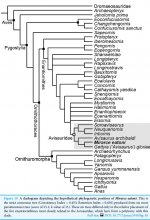Fred Ruhe
Well-known member

Jessie Atterholt, J. Howard Hutchison and Jingmai K. O’Connor, 2018
The most complete enantiornithine from North America and a phylogenetic analysis of the Avisauridae
PeerJ. 6: e5910. doi:10.7717/peerj.5910
Abstract: https://peerj.com/articles/5910/
The most complete known North American enantiornithine was collected in 1992 but never formally described. The so-called “Kaiparowits avisaurid” remains one of the most exceptional Late Cretaceous enantiornithine fossils. We recognize this specimen as a new taxon, Mirarce eatoni (gen. et sp. nov.), and provide a complete anatomical description. We maintain that the specimen is referable to the Avisauridae, a clade previously only known in North America from isolated tarsometatarsi. Information from this specimen helps to clarify evolutionary trends within the Enantiornithes. Its large body size supports previously observed trends toward larger body mass in the Late Cretaceous. However, trends toward increased fusion of compound elements across the clade as a whole are weak compared to the Ornithuromorpha. The new specimen reveals for the first time the presence of remige papillae in the enantiornithines, indicating this feature was evolved in parallel to dromaeosaurids and derived ornithuromorphs. Although morphology of the pygostyle and (to a lesser degree) the coracoid and manus appear to remain fairly static during the 65 million years plus of enantiornithine evolution, by the end of the Mesozoic at least some enantiornithine birds had evolved several features convergent with the Neornithes including a deeply keeled sternum, a narrow furcula with a short hypocleidium, and ulnar quill knobs—all features that indicate refinement of the flight apparatus and increased aerial abilities. We conduct the first cladistic analysis to include all purported avisuarid enantiornithines, recovering an Avisauridae consisting of a dichotomy between North and South American taxa. Based on morphological observations and supported by cladistic analysis, we demonstrate Avisaurus to be paraphyletic and erect a new genus for “A. gloriae,” Gettyia gen. nov.
Free pdf: https://peerj.com/articles/5910.pdf
Enjoy,
Fred
The most complete enantiornithine from North America and a phylogenetic analysis of the Avisauridae
PeerJ. 6: e5910. doi:10.7717/peerj.5910
Abstract: https://peerj.com/articles/5910/
The most complete known North American enantiornithine was collected in 1992 but never formally described. The so-called “Kaiparowits avisaurid” remains one of the most exceptional Late Cretaceous enantiornithine fossils. We recognize this specimen as a new taxon, Mirarce eatoni (gen. et sp. nov.), and provide a complete anatomical description. We maintain that the specimen is referable to the Avisauridae, a clade previously only known in North America from isolated tarsometatarsi. Information from this specimen helps to clarify evolutionary trends within the Enantiornithes. Its large body size supports previously observed trends toward larger body mass in the Late Cretaceous. However, trends toward increased fusion of compound elements across the clade as a whole are weak compared to the Ornithuromorpha. The new specimen reveals for the first time the presence of remige papillae in the enantiornithines, indicating this feature was evolved in parallel to dromaeosaurids and derived ornithuromorphs. Although morphology of the pygostyle and (to a lesser degree) the coracoid and manus appear to remain fairly static during the 65 million years plus of enantiornithine evolution, by the end of the Mesozoic at least some enantiornithine birds had evolved several features convergent with the Neornithes including a deeply keeled sternum, a narrow furcula with a short hypocleidium, and ulnar quill knobs—all features that indicate refinement of the flight apparatus and increased aerial abilities. We conduct the first cladistic analysis to include all purported avisuarid enantiornithines, recovering an Avisauridae consisting of a dichotomy between North and South American taxa. Based on morphological observations and supported by cladistic analysis, we demonstrate Avisaurus to be paraphyletic and erect a new genus for “A. gloriae,” Gettyia gen. nov.
Free pdf: https://peerj.com/articles/5910.pdf
Enjoy,
Fred
Last edited:




